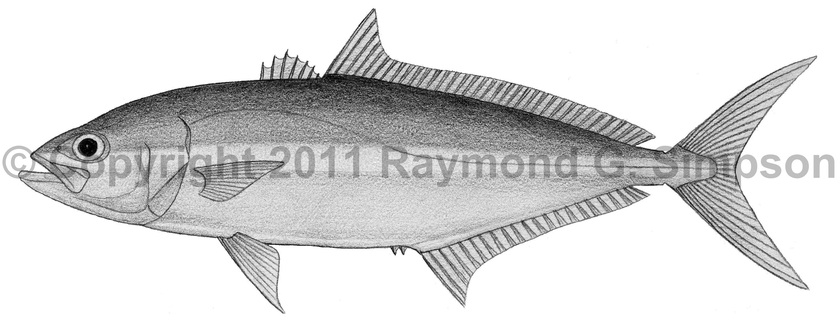
Common Name
Yellowtail Amberjack
Year Described
Valenciennes, 1830
Identification
Dorsal Fin: 7 spines, followed by I, 30-35
Anal Fin: 2 spines (reduced and embedded in large fish), followed by I, 19-22
Pelvic Fin: I, 5
Gill Rakers: 7-10 upper, 15-20 lower; 19-22 total
Vertebrae: 10 precaudal, 14 caudal
Elongate and moderately deep bodied. Jaw extends to the anterior margin of eye. Supramaxilla slender. Teeth minute and present in both jaws. Spiny first dorsal much lower than second dorsal. Second dorsal base longer than anal fin base. Second dorsal and anal fin have raised anterior lobes with dorsal lobe smaller or equal in size to the pectoral fin. Pelvic fins larger than pectoral fin. Lateral line with a shallow anterior arch and a straight posterior portion with no scutes. Caudal peduncle grooves present. Fleshy lateral keel on caudal peduncle. Body smooth with tiny cycloid scales. First anal pterygiophore curved in fish >10cm.
Color
Body bluish to dusky olive above, with a golden lateral band from eye to tail, and a white belly. Fins yellowish. Juveniles with irregular dusky bars present, not extending onto fins.
Size
Averages to 80cm. Maximum size to 250cm.
Habitat
Pelagic in offshore waters
Range
Southwestern Atlantic from Brazil to Argentina.
References
Allen , G.R. and Robertson, D.R., 1994., Fishes of the Tropical Eastern Pacific., Crawford House Press Pty Ltd:1-332.
Smith-Vaniz, W.F., 1984. Carangidae. In W. Fischer and G. Bianchi (eds.) FAO species identification sheets for fishery purposes. Western Indian Ocean fishing area 51. Vol. 1. [pag. var.]. FAO, Rome.